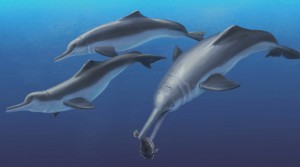A new species of extinct dolphin closely related to modern Amazonian ‘river dolphins’, but which dwelled in ancient oceans, is helping to solve the mystery of how and when dolphins adapted for life away from the sea.
Freshwater dolphins are endangered, largely due to human activity. In modern ecosystems, only five or six species remain, and among these, the Yangtze ‘river dolphin’ was declared ‘functionally extinct’ in 2006.
These animals are truly remarkable, and show what scientists have interpreted as adaptations for helping to navigate the murky waters of the winding rivers they inhabit: broad, paddle-shaped flippers, and long narrow snouts – much longer than their modern, sea-dwelling cousins – and flexible necks for catching rapidly darting prey.

An artist’s recreation of Isthminia panamensis feeding on a flatfish. Many features of this new species appear similar to today’s ocean dolphins, yet the new fossil species is more closely related to the living Amazon River dolphin. Image: Julia Molnar / Smithsonian Institution
Scientists from the Smithsonian discovered a new genus and species of extinct ‘river dolphin’, hailing from the Caribbean Coast of Panama 6 million years ago during a time known as the Miocene. Based on a skull and parts of the right flipper, they estimate it could grow to more than 9 feet in length, just slightly larger than its modern relatives. The new animal is named Isthminia panamensis, as a dedication to the people of the Republic of Panama, and the many scientists who’ve studied the biology and geology of the region.
